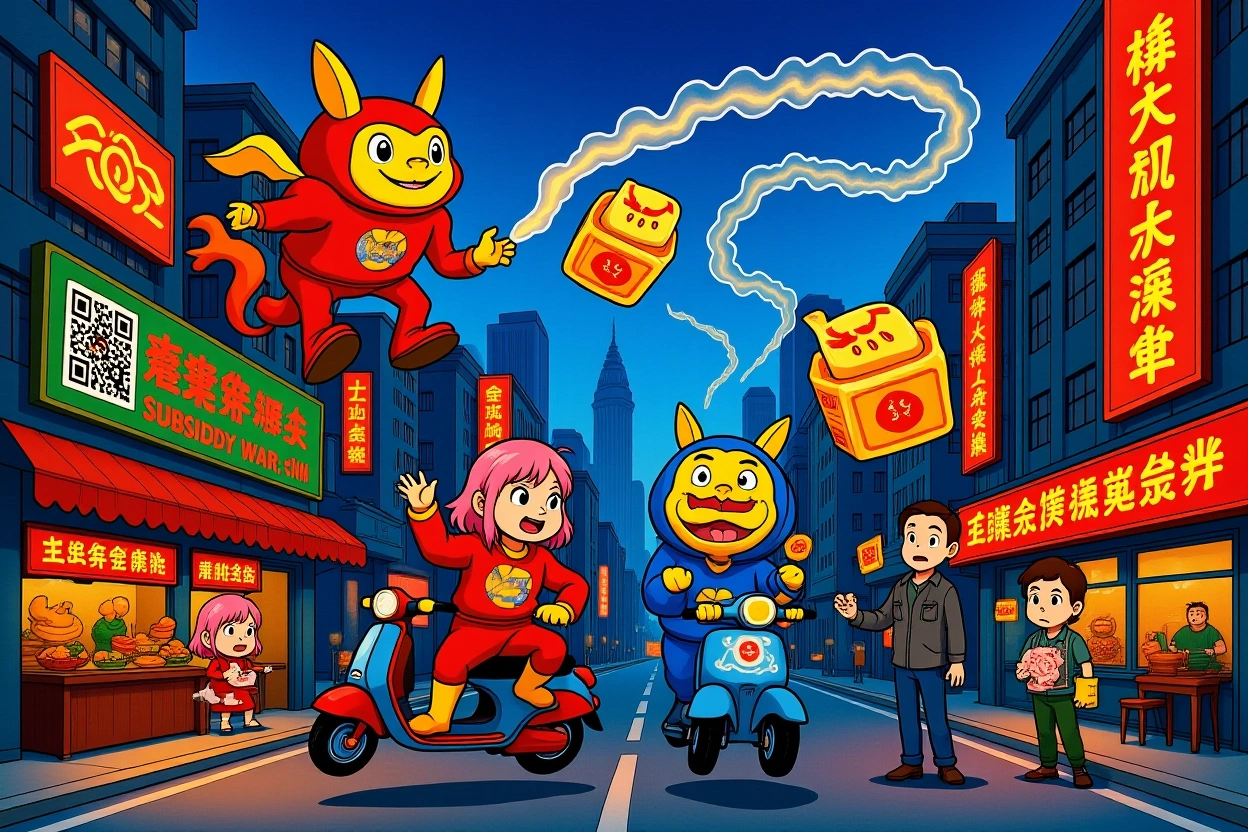• Intensified subsidy wars persist despite double regulatory warnings
• Restaurants face profitability crisis with 83% reporting margin declines
• Alibaba stabilizes orders while JD enters self-operated kitchen space
• $800+ million daily subsidies threaten industry’s $30B annual profits
• Strategic shifts emerge as platforms pivot toward operational substance
China’s food delivery arena has transformed into a financial battleground where titans deploy capital like artillery shells. When regulatory authorities summoned Ele.me, Meituan, and JD.com executives for the second time in two months on July 18 – warning against “irrational competition” – industry observers anticipated ceasefire talks. Instead, the very next weekend saw intensified bombardment: Ele.me’s “25元减25元” coupons, Meituan’s surprise free ice cream vouchers, and JD.com’s “15减14” newcomer discounts flooded consumer apps. This trillion-yuan food delivery battle showcases corporate resolve hardening even as restaurant bankruptcies multiply beneath the digital crossfire. Three dynamics shape this conflict: unsustainable subsidies crushing merchants, strategic pivots toward operational substance, and mutual industry paralysis where no player dares retreat from financial trenches first.
Persistent Subsidies Despite Regulatory Warnings
Platforms demonstrate alarming disregard for oversight bodies. Days after the State Administration for Market Regulation’s mid-July summons, promotional fireworks lit up urban centers. Ele.me relaunched its group-buy program as “爆品团” (Explosive Deals Group), featuring $0.70 milk teas and $1.40 burger combos beneath banners promising “official double subsidies.” Simultaneously, Taobao Quick Deals ignited social media with its “Super Saturday” campaign – viral 19-yuan ($2.60) no-minimum coupons propelling hashtag #淘宝闪购外卖1块9# (Taobao Quick Deals $0.26 takeout) to Weibo’s trending charts. Meituan countered through its “Pintianfan” channel, announcing 10,000 new brand partnerships while dispensing mystery food vouchers. JD maintained pressure with newcomer-directed “20减16” deals – essentially 80% discounts hemorrhaging cash yet pursued relentlessly.
Restaurant Anguish Reaches Breaking Point
Merchants trapped in this crossfire voice unprecedented distress. Jia Guolong (贾国龙), founder of 400-store chain Xibei, publicly pleaded: “Restaurants deserve pricing autonomy. Current practices wreck industry ecosystems.” Liu Jingjing (刘京京) of Beijing-based Jiāhé Yīpǐn stated bluntly: “Participating means losses, but skipping means invisibility.” Her prediction of mass closures found evidence in Zunyi City Chamber of Commerce data: 83% of local restaurants reported profit erosion from subsidy participation. Meituan executive Wang Puzhong (王莆中) acknowledged the unsustainability, telling LatePost: “We see first-line realities behind inflated numbers.”
The Capital Pyre
This food delivery battle consumes astonishing resources:
– Alibaba allocated $8.4 billion to Ele.me and Taobao Quick Deals
– JD deployed $2.8 billion across mid-2024 promotions
– Meituan reportedly burned $8 million daily in peak periods
Financial analysts highlight terrifying context: The entire industry generated $30 billion revenue last year, dwarfed by competitors spending $800+ million weekly. Continuous cash immolation creates prisoner’s dilemma dynamics – withdrawal means forfeiting sunk investments.
The Strategy Evolution
When bleeding becomes unsustainable, innovation emerges. Platforms now shift from cash missiles toward structural renovations:
Alibaba: Stabilization Over Expansion
Internal leaks reveal Taobao Quick Deals abandoning its ambitious 100-million daily order target. Anonymous Alibaba sources confirmed new instructions: “Secure the 80-million-order base before advancing.” Analysts interpret this as consolidation – fixing fulfillment infrastructure overwhelmed during June’s discount-driven surge.
JD’s Radical Kitchen Gambit
JD Founder Liu Qiangdong (刘强东) unveiled his trump card on July 22: Self-operated chain “Qixian Little Chef” (七鲜小厨). This delivery-and-pickup hybrid offers chefs $14,000 upfront plus unlimited profit-sharing to own specific dishes. With promised 10,000 locations in three years, Beijing’s pilot store serves $1.40-$2.80 dishes like mapo tofu during testing. The model transfers inventory risk from restaurants to JD while controlling quality – a potential blueprint for sustainable scale.
Meituan’s Branded Retreat
The industry leader minimizes headlines while strengthening premium partnerships. Its “10,000 Brands Project” emphasizes recognizable chains over mom-and-pop shops, pursuing quality impressions versus sheer volume. Wang Puzhong signaled strategic prioritization: “Currently, JD concerns me less than Alibaba’s systems,” indicating Meituan’s gaze shifted toward its strongest rival.
The Inevitable Economic Reckoning
Physics dictates what corporate bravado denies: Unlimited subsidy wars defy gravity. Wang Puzhong outlined the vicious cycle: “Promising penalty-free late deliveries invites systematic gaming during peak hours.” Mid-2024 realities worsen:
– Restaurant profit margins compressed below 5%
– Delivery workforce costs surging 18% annually
– Platform take rates approaching 25% pre-subsidy
The trillion-yuan food delivery battle now resembles three swimmers chained together – one stopping pulls all under. When LatePost asked whether prolonged conflict could bleed Meituan dry, Wang responded: “Our wars span multiple fronts: Double 11, AI, overseas. Enterprise resources demand allocation.”
Platform strategies increasingly prioritize operational substance over financial spectacle. JD’s central kitchens could redefine food preparation efficiency. Meituan’s brand partnerships may improve product consistency. Alibaba’s infrastructure reinforcement promises reliable delivery experiences. Ultimately, resolution may arrive via regulatory intervention – authorities historically capitated DiDi’s ride-hailing wars when discounts approached 80%.
The coming quarter will reveal whether China’s delivery giants redirect capital from unsustainable subsidies toward innovative operational systems. For restaurants drowning beneath algorithmic currents, substantive innovation promises rescue from capital-fueled whirlpools. Until equilibrium emerges, stakeholders should scrutinize platform partnerships favoring supply-chain resilience over momentary visibility gains – because victory favors operators whose kitchens function after the fireworks fade.




